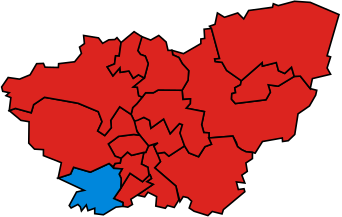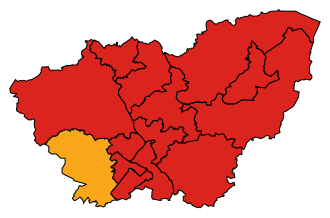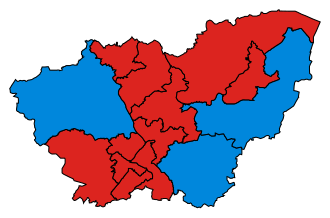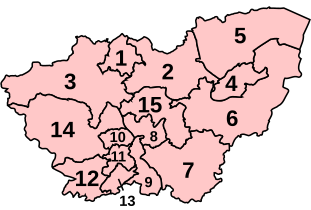List of Parliamentary constituencies in South Yorkshire
The ceremonial county of South Yorkshire is divided into 14 Parliamentary constituencies – 7 Borough constituencies and 7 County constituencies.
Sheffield Hallam was the only non-Labour South Yorkshire seat for many years, and was held by Nick Clegg for 12 years, until Labour gained the seat in 2017. For a 22-year period spanning 1997–2019, the Conservatives had no seats in South Yorkshire, until the 2019 election, when they gained three. In the 1980s, the region's socialist activity (particularly in local government) led to it being referred to as the "People's Republic of South Yorkshire", it being dominated by Labour, a party with a strong socialist tradition. However, it was not until 2017 that every seat in South Yorkshire was won by Labour, a feat which was not repeated at the subsequent 2019 election.[1]
Constituencies[]
† Conservative ‡ Labour ¤ Liberal Democrat # Brexit Party
| Constituency[nb 1] | Electorate[2] | Majority[3][nb 2] | Member of Parliament[3] | Nearest Opposition[3] | Electoral wards[4][5] | Map | ||
|---|---|---|---|---|---|---|---|---|
| Barnsley Central | 65,277 | 3,571 | Dan Jarvis‡ | Victoria Felton# | Barnsley Metropolitan Borough Council: Central, Darton East, Darton West, Kingstone, Monk Bretton, Old Town, Royston, St Helens. |  | ||
| Barnsley East | 69,504 | 3,217 | Stephanie Peacock‡ | Jim Ferguson# | Barnsley Metropolitan Borough Council: Cudworth, Darfield, Hoyland Milton, North East, Rockingham, Stairfoot, Wombwell, Worsbrough. |  | ||
| Don Valley | 75,356 | 3,630 | Nick Fletcher† | Caroline Flint‡ | Doncaster Metropolitan Borough Council: Conisbrough and Denaby, Edlington and Warmsworth, Finningley, Hatfield, Rossington, Thorne, Torne Valley. |  | ||
| Doncaster Central | 71,389 | 2,278 | Rosie Winterton‡ | Roberto Weeden-Sanz† | Doncaster Metropolitan Borough Council: Armthorpe, Balby, Bessacarr and Cantley, Central, Edenthorpe, Kirk Sandall and Barnby Dun, Town Moor, Wheatley. |  | ||
| Doncaster North | 72,362 | 2,370 | Ed Miliband‡ | Katrina Sale† | Doncaster Metropolitan Borough Council: Adwick, Askern Spa, Bentley, Great North Road, Mexborough, Sprotbrough, Stainforth and Moorends. |  | ||
| Penistone and Stocksbridge | 70,925 | 7,210 | Miriam Cates† | Francyne Johnson‡ | Barnsley Metropolitan Borough Council: Dodworth, Penistone East, Penistone West. Sheffield City Council: East Ecclesfield, Stocksbridge and Upper Don, West Ecclesfield. |  | ||
| Rother Valley | 74,804 | 6,318 | Alexander Stafford† | Sophie Wilson‡ | Rotherham Metropolitan Borough Council: Anston and Woodsetts, Dinnington, Hellaby, Holderness, Maltby, Rother Vale, Sitwell, Wales. |  | ||
| Rotherham | 61,688 | 3,121 | Sarah Champion‡ | Gerri Hickton† | Rotherham Metropolitan Borough Council: Boston Castle, Brinsworth and Catcliffe, Keppel, Rotherham East, Rotherham West, Valley, Wingfield. |  | ||
| Sheffield Brightside and Hillsborough | 69,333 | 12,274 | Gill Furniss‡ | Hannah Westropp† | Sheffield City Council: Burngreave, Firth Park, Hillsborough, Shiregreen and Brightside, Southey. |  | ||
| Sheffield Central | 89,949 | 27,273 | Paul Blomfield‡ | Janice Silvester-Hal† | Sheffield City Council: Broomhill, Central, Manor Castle, Nether Edge. Walkley. |  | ||
| Sheffield Hallam | 72,763 | 712 | Olivia Blake‡ | Laura Gordon¤ | Sheffield City Council: Crookes, Dore and Totley, Ecclesall, Fulwood, Stannington. |  | ||
| Sheffield Heeley | 66,940 | 8,480 | Louise Haigh‡ | Gordon Gregory† | Sheffield City Council: Arbourthorne, Beauchief and Greenhill, Gleadless Valley, Graves Park, Richmond. |  | ||
| Sheffield South East | 67,832 | 4,289 | Clive Betts‡ | Marc Bayliss† | Sheffield City Council: Beighton, Birley, Darnall, Mosborough, Woodhouse. |  | ||
| Wentworth and Dearne | 74,536 | 2,165 | John Healey‡ | Emily Barley† | Barnsley Metropolitan Borough Council: Dearne North, Dearne South. Rotherham Metropolitan Borough Council: Hoober, Rawmarsh, Silverwood, Swinton, Wath, Wickersley. |  | ||
2010 boundary changes[]
Under the Fifth Periodic Review of Westminster constituencies, the Boundary Commission for England decided to reduce the number of seats in South Yorkshire from 15 to 14, leading to significant changes. Barnsley East and Mexborough, Barnsley West and Penistone, Sheffield, Brightside, and Sheffield, Hillsborough were abolished and replaced by Barnsley East, Penistone and Stocksbridge, and Sheffield, Brightside and Hillsborough. Sheffield, Attercliffe was renamed Sheffield South East, and Wentworth was renamed Wentworth and Dearne.
Proposed boundary changes[]
See 2023 Periodic Review of Westminster constituencies for further details.
Following the abandonment of the Sixth Periodic Review (the 2018 review), the Boundary Commission for England formally launched the 2023 Review on 5 January 2021 and published their initial proposals on 8 June 2021.[6]
The Commission has proposed that South Yorkshire be combined with Humberside as a sub-region of the Yorkshire and the Humber Region, resulting in the creation of a new cross-county boundary constituency named Doncaster East and Axholme, largely replacing Don Valley. Barnsley Central and Barnsley East would be realigned to form Barnsley North and Barnsley South. Changes to Wentworth and Dearne would result in it being renamed Rawmarsh and Conisbrough, and it is proposed that Doncaster Central is renamed Doncaster Town.[7][8]
The following constituencies are proposed:
Containing electoral wards from Barnsley
Containing electoral wards from Doncaster
- (part also in North Lincolnshire)
- Doncaster North CC
- (part)
Containing electoral wards from Rotherham
- Rawmarsh and Conisbrough CC (part)
- Rother Valley CC
- Rotherham BC
Containing electoral wards from Sheffield
- Penistone and Stocksbridge CC (part)
- Sheffield Brightside and Hillsborough BC
- Sheffield Central BC
- Sheffield Hallam CC
- Sheffield Heeley BC
- Sheffield South East BC
Revised proposals will be published in late 2022 and the final report will be submitted in June 2023.
Results history[]
Primary data source: House of Commons research briefing - General election results from 1918 to 2019[9]
2019[]
The number of votes cast for each political party who fielded candidates in constituencies comprising South Yorkshire in the 2019 general election were as follows:
| Party | Votes | % | Change from 2017 | Seats | Change from 2017 |
|---|---|---|---|---|---|
| Labour | 257,978 | 42.3% | 11 | ||
| Conservative | 196,969 | 32.3% | 3 | ||
| Brexit | 82,838 | 13.6% | new | 0 | 0 |
| Liberal Democrats | 47,831 | 7.8% | 0 | 0 | |
| Greens | 14,084 | 2.3% | 0 | 0 | |
| Others | 10,506 | 1.7% | 0 | 0 | |
| Total | 610,206 | 100.0 | 14 |
Percentage votes[]
| Election year | 1983 | 1987 | 1992 | 1997 | 2001 | 2005 | 2010 | 2015 | 2017 | 2019 |
|---|---|---|---|---|---|---|---|---|---|---|
| Conservative | 28.0 | 24.9 | 27.0 | 16.7 | 18.8 | 18.0 | 20.6 | 17.4 | 29.8 | 32.3 |
| Labour | 48.8 | 56.0 | 57.9 | 62.3 | 59.0 | 52.7 | 42.0 | 49.5 | 56.9 | 42.3 |
| Liberal Democrat1 | 23.0 | 18.9 | 14.5 | 16.6 | 18.0 | 21.4 | 23.7 | 8.2 | 5.9 | 7.8 |
| Green Party | - | * | * | * | * | * | 0.6 | 2.7 | 1.2 | 2.3 |
| UKIP | - | - | - | * | * | * | 4.4 | 20.8 | 4.7 | * |
| Brexit Party | - | - | - | - | - | - | - | - | - | 13.6 |
| Other | 0.2 | 0.2 | 0.6 | 4.4 | 4.1 | 8.0 | 8.7 | 1.6 | 1.5 | 1.7 |
11983 & 1987 - SDP-Liberal Alliance
* Included in Other
Seats[]
| Election year | 1983 | 1987 | 1992 | 1997 | 2001 | 2005 | 2010 | 2015 | 2017 | 2019 |
|---|---|---|---|---|---|---|---|---|---|---|
| Conservative | 1 | 1 | 1 | 0 | 0 | 0 | 0 | 0 | 0 | 3 |
| Labour | 14 | 14 | 14 | 14 | 14 | 14 | 13 | 13 | 14 | 11 |
| Liberal Democrat1 | 0 | 0 | 0 | 1 | 1 | 1 | 1 | 1 | 0 | 0 |
| Total | 15 | 15 | 15 | 15 | 15 | 15 | 14 | 14 | 14 | 14 |
11983 & 1987 - SDP-Liberal Alliance
Maps[]

1983

1987

1992

1997

2001

2005

2010

2015

2017

2019
Historical representation by party[]
A cell marked → (with a different colour background to the preceding cell) indicates that the previous MP continued to sit under a new party name.
Change UK Conservative Independent Labour Liberal Democrats
| Constituency | 1983 | 1987 | 1992 | 94 | 96 | 1997 | 2001 | 2005 | 2010 | 10 | 11 | 12 | 12 | 2015 | 16 | 2017 | 18 | 19 | 19 | 2019 |
|---|---|---|---|---|---|---|---|---|---|---|---|---|---|---|---|---|---|---|---|---|
| Barnsley West and Penistone / P & Stocksbridge (2010) | McKay | Clapham | Smith | → | → | Cates | ||||||||||||||
| Don Valley | Redmond | Flint | Fletcher | |||||||||||||||||
| Rother Valley | Barron | Stafford | ||||||||||||||||||
| Barnsley Central | Mason | Illsley | → | Jarvis | ||||||||||||||||
| Barnsley East (1983–1997, 2010–) / & Mexborough (1997–2010) | Patchett | Ennis | Dugher | Peacock | ||||||||||||||||
| Doncaster Central | Walker | Winterton | ||||||||||||||||||
| Doncaster North | Welsh | Hughes | Miliband | |||||||||||||||||
| Rotherham | Crowther | Boyce | MacShane | → | → | Champion | ||||||||||||||
| Sheffield Attercliffe / Sheffield SE (2010) | Duffy | Betts | ||||||||||||||||||
| Sheffield Brightside / & Hillsborough (2010) | Maynard | Blunkett | Harpham | Furniss | ||||||||||||||||
| Sheffield Central | Caborn | Blomfield | ||||||||||||||||||
| Sheffield Hallam | Osborn | Patnick | Allan | Clegg | O'Mara | → | Blake | |||||||||||||
| Sheffield Heeley | Michie | Munn | Haigh | |||||||||||||||||
| Wentworth / Wentworth and Dearne (2010) | Hardy | Healey | ||||||||||||||||||
| Sheffield Hillsborough | Flannery | Jackson | Smith | |||||||||||||||||
See also[]
- List of Parliamentary constituencies in Yorkshire and the Humber (region)
Notes[]
References[]
- ^ Linda McDowell (2011). Redundant Masculinities? Employment Change and White Working Class Youth. ISBN 978-1444355598.
... local politics in Sheffield were dominated by a particular form of radical municipal socialism, gaining the city a brief but prestigious reputation as the Socialist Republic of South Yorkshire.
- ^ Baker, Carl; Uberoi, Elise; Cracknell, Richard (28 January 2020). "General Election 2019: full results and analysis". Retrieved 25 April 2020.
- ^ a b c "Constituencies A-Z - Election 2019". BBC News. Retrieved 25 April 2020.
- ^ "The Parliamentary Constituencies (England) Order 2007, page 4". Office of Public Sector Information. Crown copyright. 13 June 2007. Retrieved 7 November 2009.
- ^ Boundary Commission for England pp. 1004–1007
- ^ "2023 Review | Boundary Commission for England". boundarycommissionforengland.independent.gov.uk. Retrieved 6 October 2021.
- ^ The new Yorkshire borders that could create 18 new constituencies by next General Election YorkshireLive
- ^ 2023 review Yorkshire and the Humber Boundary Commission for England
- ^ Watson, Christopher; Uberoi, Elise; Loft, Philip (17 April 2020). "General election results from 1918 to 2019".
- Parliamentary constituencies in Yorkshire and the Humber
- Lists of constituencies of the Parliament of the United Kingdom in England
- Politics of South Yorkshire
- South Yorkshire-related lists






